 Music
Music  Music
Music  History
History 10 Less Than Jolly Events That Occurred on December 25
 Weird Stuff
Weird Stuff 10 Funny Ways That Researchers Overthink Christmas
 Politics
Politics 10 Political Scandals That Sent Crowds Into the Streets
 Weird Stuff
Weird Stuff Ten Bizarre Facts About The Doge Meme
 Our World
Our World 10 Ways Your Christmas Tree Is More Lit Than You Think
 Movies and TV
Movies and TV The 10 Coolest Stars to Set Sail on The Love Boat
 History
History 10 Things You Didn’t Know About the American National Anthem
 Technology
Technology Top 10 Everyday Tech Buzzwords That Hide a Darker Past
 Humans
Humans 10 Everyday Human Behaviors That Are Actually Survival Instincts
 Music
Music 10 Surprising Origin Stories of Your Favorite Holiday Songs
 History
History 10 Less Than Jolly Events That Occurred on December 25
 Weird Stuff
Weird Stuff 10 Funny Ways That Researchers Overthink Christmas
Who's Behind Listverse?

Jamie Frater
Head Editor
Jamie founded Listverse due to an insatiable desire to share fascinating, obscure, and bizarre facts. He has been a guest speaker on numerous national radio and television stations and is a five time published author.
More About Us Politics
Politics 10 Political Scandals That Sent Crowds Into the Streets
 Weird Stuff
Weird Stuff Ten Bizarre Facts About The Doge Meme
 Our World
Our World 10 Ways Your Christmas Tree Is More Lit Than You Think
 Movies and TV
Movies and TV The 10 Coolest Stars to Set Sail on The Love Boat
 History
History 10 Things You Didn’t Know About the American National Anthem
 Technology
Technology Top 10 Everyday Tech Buzzwords That Hide a Darker Past
 Humans
Humans 10 Everyday Human Behaviors That Are Actually Survival Instincts
10 Worldwide Insect Delicacies
Expanding one’s palate has been a fad which has never aged. Chefs are always looking for new ways to spice up old dishes, as well as various techniques to utilize in making something that seems bland-tasting sublime. Meat is often a staple, and it’s a good source of protein. However, for some countries, meat isn’t the only protein option. In fact, for some countries, while meat may be the centerpiece of meals, another source of protein is more versatile—and more commonly available. That protein? Insects.
In many countries, eating insects is normal. In fact, history has shown that insects were a popular source of food even back in the times of the Romans and Greeks. A recent study has shown that over two billion people across the world eat insects.[1] It’s not uncommon for people in South America, Europe, and Asia to not only eat insects but grow them for that purpose alone. Also, 100 percent of an insect is edible, compared to only 40 percent of a cow.
Insects can be served a variety of different ways, from snacks to main courses to even desserts.
10 Thailand: Crickets
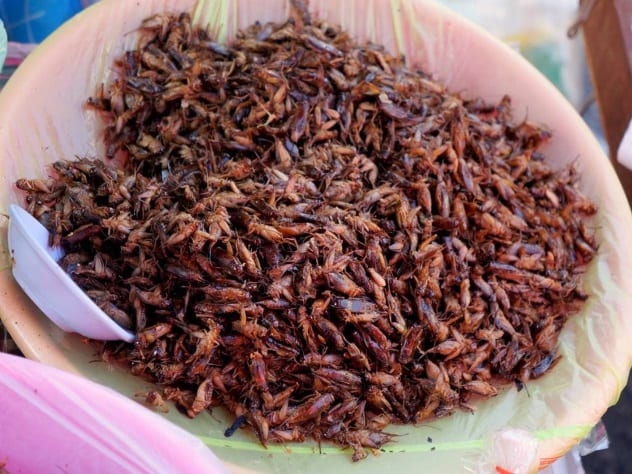
Eating insects is not unheard-of in Thailand; in fact, they’re often found as a very accessible snack. Insects can be cooked in a myriad of different ways, ranging from frying them to baking them to serving them raw. One of the most popular insect dishes in Thailand is referred to as Jing Leed, which is the frying of crickets.[2] Most commonly, Jing Leed is sold as a deep-fried snack by street vendors. It is made by first frying the crickets in a wok for only a few moments before seasoning them with Golden Mountain sauce (which is akin to a form of soy sauce) and Thai pepper powder.
Crickets are not only used in Thailand because of their abundance but also because they offer a variety of minerals, such as calcium, copper, and zinc, which are also found in beef. It is recommended when enjoying this deep-fried treat to pair it with beer. Jing Leed is said to taste similar to popcorn. Yum.
9 China: Live Scorpions
Some of the finest delicacies in China are insects. Insects can be served in all forms, be it boiling water bugs or serving roasted bee larvae. The tradition of eating insects has predominated in China for ages, tracing back for centuries. For many, insects are used as a cheaper, easier way of surviving, as many insects provide the same proteins found in the meat of chicken and pigs. For others, some insects are viewed as a treat to be served in only the finest of restaurants.
While they’re not insects, scorpions are also consumed in China. No matter where they’re being served, one thing is consistent: They’re live. Live scorpions are prepared simply: They’re sprinkled with seasoning and then dunked into hot oil before being served.[3]
In the cases were live scorpions are served in finer restaurants, they are first dunked in a fine white wine sauce before being fried, providing patrons with what is supposedly a sweet yet . . . crunchy experience.
8 Japan: Wasps
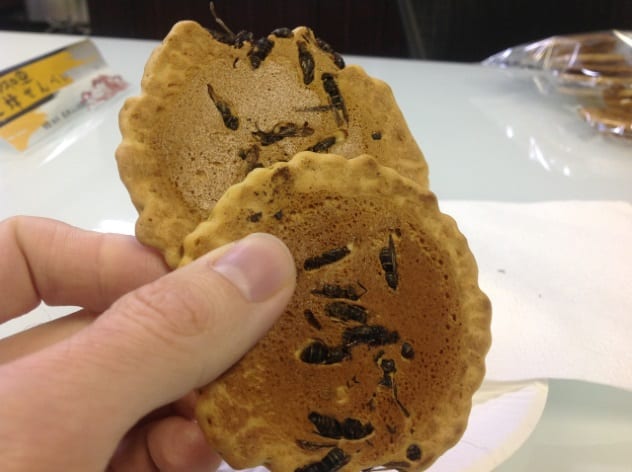
In Japan, celebrations surrounding the eating of insects are not uncommon. In most rural parts of Japan, in fact, they have festivals for such events, one of which is the the Kushihara Wasp Festival, which celebrates wasps and different methods of eating them. Japan serves wasps in various different ways, one being where a wasp is ground up and turned into various different flavors of sauces, which are used to top such things as rice cookies. Another is where wasps are cooked and placed inside agar-agar jelly, leaving the wasp encased inside the gelatinous mound. In other cases, wasps are marinated in ginger and placed upon sushi.
A specific wasp delicacy in Japan is wasp crackers.[4] These crackers, which seem similar to American cookies, are filled with surprises inside. However, they aren’t the treats we’re used to, though they sure do look like them. These cookies are sold in packs of two and are said to resemble a treat filled with raisins—if those raisins were bitter and had wings.
7 Mexico: Stinkbugs
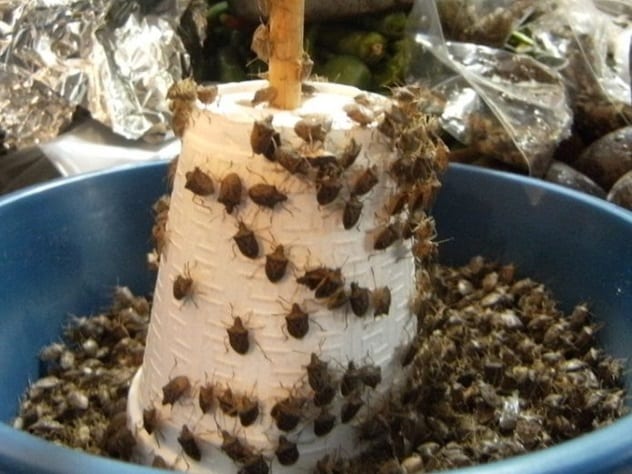
Mexico’s usage of insects in dishes has been traced back to when the indigenous tribes filled the land. Now, edible insects are still common in the outskirts of Mexico. Meanwhile, the bigger cities tend to use them as gourmet options in pricey restaurants.
One insect that is commonly eaten in Mexico, whether live or cooked, is the stinkbug. This insect even has a festival held for it.[5] The Jumil Festival honors stinkbugs, which are believed to hold medicinal, as well as aphrodisiacal, effects, along with high amounts of protein and minerals.
Stinkbugs can be dipped in sauce and served live, where the odor of the stinkbug is something that only some can fully appreciate. Others toast the stinkbugs and place them inside tortillas, as either the meat or as toppings. They can also be made into pico de gallo and guacamole sides.
The stinkbug is said to have a spicy taste, if one can stomach both the taste along with the smell.
6 Indonesia: Dragonflies
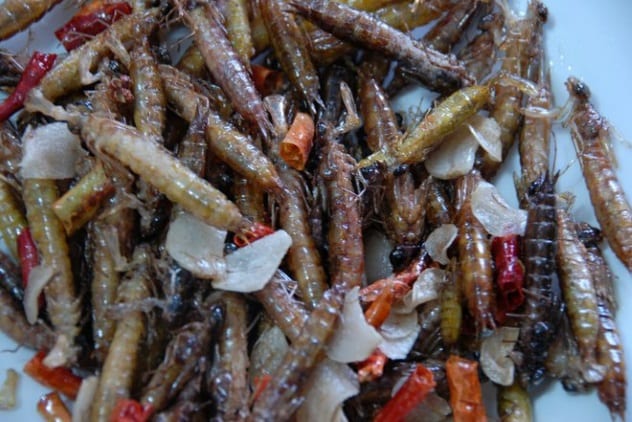
In areas where mosquitoes are everywhere, having dragonflies around is extremely helpful. These insects, which feed on mosquitoes, are beneficial to keeping them away and keeping them from biting—but dragonflies serve another purpose. For the people of Indonesia, dragonflies make a very appealing snack. In order to catch the dragonfly, a stick is dipped in tree sap and then laid out for dragonflies to land on.
Dragonflies, when cooked, are not served live like some other insects. Instead, their wings are taken off as they’re prepared. The dragonflies are then either boiled or, if they’re intended for a dessert, fried before being served. The taste of a dragonfly, some say, is akin to that of crab, as is its nutritional value.[6]
5 Zimbabwe: Mopane Worm
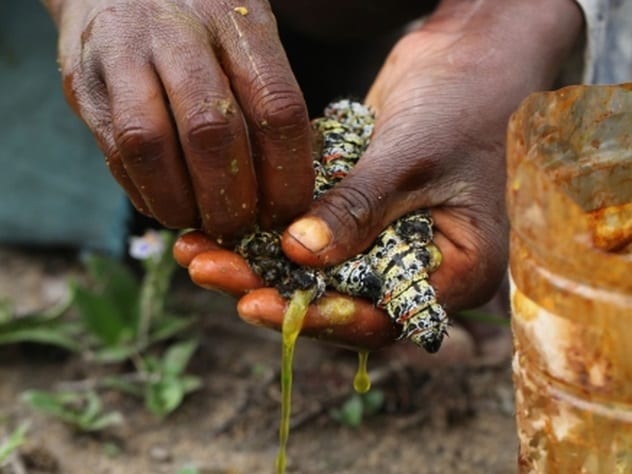
Caterpillars are not an uncommon source of protein, and many countries in Asia have turned to them as an alternative source of protein. In Zimbabwe, the mopane worm, named after its tendency to be found on the mopane tree, is a caterpillar that is not only beautiful but also delicious.
The mopane worm is a daily part of the diets of many in Zimbabwe, both in rural and urban communities. These worms can be cooked in a variety of different ways, making them a prime option. Before the mopane worms are cooked, they are first collected and squeezed until they no longer have any of their liquid green entrails left inside. Once they are emptied, they are laid out to dry in the sun.[7]
Mopane worms can be eaten dry, flattened like potato chips, or can be smoked and added to a sauce or used as the protein option for a hearty stew. The taste of a mopane worm is more bland than anything, but its protein-packed benefits make it an easy and cheap alternative to more expensive options.
4 Brazil: Ants

Ants are everywhere. They’re found under feet, in mounds, and on plates. In Brazil, ants are seen in some places as a gourmet food—one that is even surrounded by celebration. During October and November, the Brazilian people of Silverias celebrate ants not only by eating them but by also producing arts and crafts in their name.[8] Ants are considered not only a gourmet food but also one rich in protein, calcium, iron, and vitamins. Their small state also allows for them to be used in meals, for toppings, and as an easy snack on their own.
The ants are cooked in different ways. Sometimes, they’re fried; other times, they’re sauteed. Often, they’re used alongside a green vegetable or placed in a salad. In Silverias, the ants are cooked and then made into a decadent snack by being dipped in chocolate.
Ants in Brazil are supposed to taste similar to mint, so dipping them in chocolate seems makes an unlikely but tempting pairing. In other countries, ants are supposed to have different tastes, ranging from bitter to sweet.
3 Kenya: Termites

Despite the havoc and destruction termites can wreak if not managed, there are uses for termites inside the house. In Kenya, these termites are taken out of the wood they’re inside and harvested and sold by the pound. Currently, termites are less abundant than they were before and are therefore in higher demand. Many Kenyans have taken to harvesting termites for both food and profit.
In Kenya, the easiest way to prepare termites is to roast them over an open flame. Others add termites into a cornmeal porridge known as ugali, and some even add them into their tea. In smaller, rural areas, grinding termites up and feeding them to babies has been a tradition for villagers, who believe that the abundant amount of nutritional benefits that termites provide will aid in the children’s growth.[9]
Like other insects, termites can also be fried in oil and, depending on the size, provide a very satisfying bite.
2 Korea: Silkworm Pupae
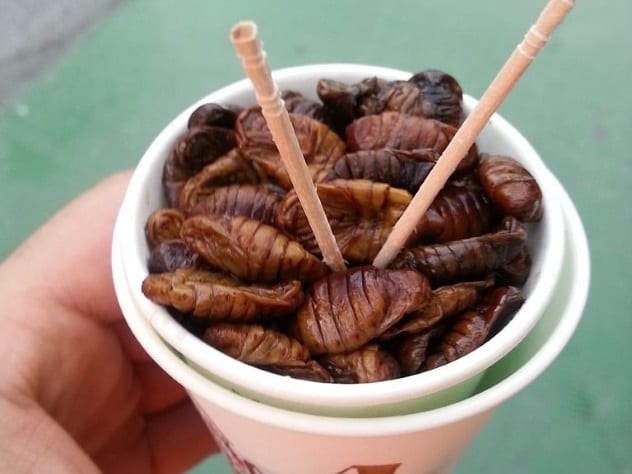
Silkworms are mostly known for their ability to produce silk and their highly prized position in places such as China. In Korea, silkworms provide much more than just a textile benefit. Their pupae are widely known for being used in a street food known as beondegi. These silkworm pupae are also sold canned, but before they are placed in a can and sold to eager customers, they are first boiled and seasoned.
The eating of silkworm pupae has been practiced for ages in Korea, and many street vendors will cook their silkworms right there, the smell being one that is deemed unforgettable and also one that cannot be missed.[10] Beondegi can be sold in a cup, right after the silkworm pupae have been boiled, seasoned, and left in a brothy liquid.
Not only are silkworm pupae increasingly popular in Korea, but they can also be purchased online and shipped to your doorstep. They are recommended to be paired with a glass of white wine.
1 Israel: Locusts
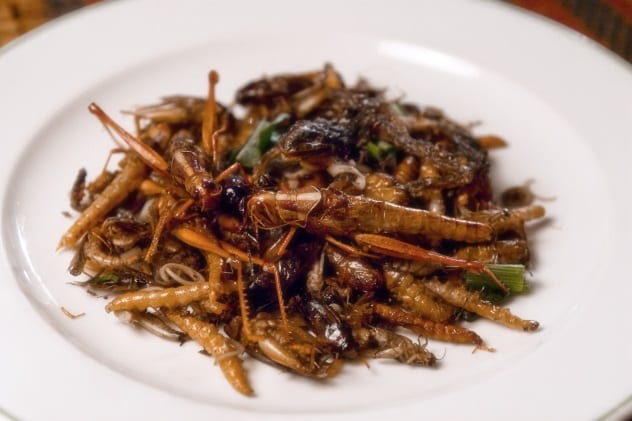
Locusts have major negative connotations in religious history. They are viewed as a bad omen, a sign of something worse to come. Despite their bad reputation, the people of Israel have found a way to give locusts a positive spin: by turning them into food.
Locusts are the only insect that is considered kosher, and in Israel, where locusts are swarming at an increasing rate, turning them into a meal seemed to be the only logical option.[11] Locusts can be eaten in different ways, but the most common is to fry them—whether it be in a pan or deep-fried. This is done in order to keep their “crunchy” texture. The locusts can first be rolled into flour, spices, and garlic before being fried, or they can be sweetened by pan-frying them and topping them with meringue.
The taste of locusts has been compared to prawns, and they are highly packed with protein and nutrients.
Read about more delicacies that might not appeal to everyone on 10 Disgusting Delicacies From Around The World and 10 Bizarre Cultural Foods Guaranteed To Make You Lose Your Lunch.
